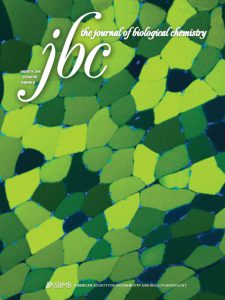
“Activating transcription factor 4 (ATF4) promotes skeletal muscle atrophy by forming a heterodimer with the transcriptional regulator C/EBPβ.” Journal of Biological Chemistry, published online January 17, 2020.
In this study, we discovered a novel molecular mechanism of skeletal muscle atrophy. In previous work, we found that a protein called ATF4 promotes muscle atrophy by activating a gene called Gadd45a. However, the biochemical mechanism by which ATF4 activates the Gadd45a gene during muscle atrophy was unknown. To identify that mechanism, we biochemically isolated skeletal muscle proteins that associate with ATF4 in skeletal muscle fibers in vivo. Interestingly, we found that ATF4 forms at least five different transcription factors in skeletal muscle fibers, but only one of these transcription factors, composed of ATF4 and a protein called C/EBPβ, causes muscle atrophy. Furthermore, we found that the ATF4-C/EBPβ transcription factor binds to a previously unknown and evolutionarily conserved regulatory element in the Gadd45a gene. This 3-way interaction between ATF4, C/EBPβ and the regulatory element activates the Gadd45a gene in skeletal muscle, leading to muscle atrophy. Please click here to obtain the paper.
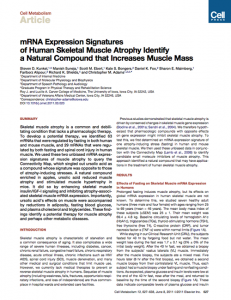
“mRNA expression signatures of human skeletal muscle atrophy identify a natural compound that increases muscle mass.” Cell Metabolism, 13: 627-638, 2011.
To identify a small molecule inhibitor of muscle atrophy, we studied human subjects to determine mRNA expression signatures of human muscle atrophy. We then searched for small molecules whose mRNA expression signatures negatively correlate to signatures of human muscle atrophy. This unbiased screen revealed ursolic acid, a natural compound found in apples. Ursolic acid possesses a favorable safety profile, but its effects on skeletal muscle were unknown. To test the hypothesis that ursolic acid might inhibit muscle atrophy, we used mouse models and discovered that ursolic acid has a previously unrecognized capacity to increase skeletal muscle mass, quality and strength, leading to protection from muscle atrophy. In addition, we found that ursolic acid promotes fat loss and reduces blood glucose. These results identified ursolic acid as a novel potential therapy for muscle atrophy and other metabolic diseases. Please click here to read the full paper.
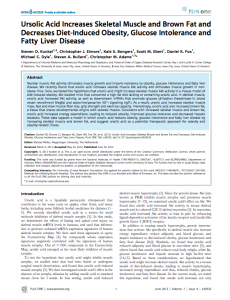
“Ursolic acid increases skeletal muscle and brown fat and decreases diet-induced obesity, glucose intolerance and fatty liver disease.” PLOS ONE, 7: e39332, 2012.
Humans and animals possess two types of fat: 1) white fat, which stores calories and contributes to obesity, and 2) brown fat, a rare type of fat that resembles skeletal muscle. In contrast to white fat, brown fat burns calories instead of storing them and protects against obesity and obesity-related disease. Thus, increasing brown fat is widely viewed as a promising method for treating obesity and obesity-related disease in humans. In this study, we discovered that ursolic acid increases both brown fat and skeletal muscle in obese mice. By increasing both brown fat and skeletal muscle, ursolic acid increases energy expenditure (burning of calories) and reduces obesity, pre-diabetes and fatty liver disease. Please click here to read the full paper.
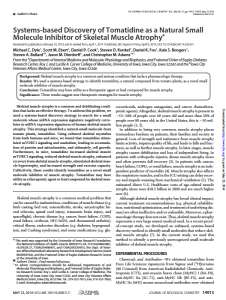
“Systems-based discovery of tomatidine as a natural small molecule inhibitor of skeletal muscle atrophy.” Journal of Biological Chemistry, 289: 14913-14924, 2014.
Another benefit of our work on ursolic acid is that it served as proof-of-concept for our systems-based discovery platform. In this study, we reused the same platform to identify tomatidine, a natural compound from tomatoes. We discovered that tomatidine stimulates growth of human muscle cells, and in mouse models, tomatidine inhibits muscle atrophy, increases muscle mass, strength, and exercise capacity, and decreases fat. Please click here to read the full paper.
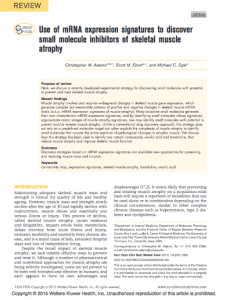
“Use of mRNA Expression Signatures to Discover Small Molecule Inhibitors of Skeletal Muscle Atrophy.” Current Opinion in Clinical Nutrition and Metabolic Care, 18: 263-268, 2015.
In this invited review, we discuss our systems-based discovery platform and how we used it to discover ursolic acid and tomatidine. Please click here to read the full paper.
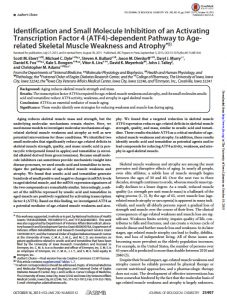
“Identification and small molecule inhibition of an ATF4-dependent pathway to age-related skeletal muscle weakness and atrophy.” Journal of Biological Chemistry, 290: 25497-25511, 2015.
In this study, we discovered that ursolic acid and tomatidine inhibit effects of aging on skeletal muscle strength, quality, and mass. In addition, we investigated how ursolic acid and tomatidine reduce age-related muscle weakness and atrophy, leading us to discover the first example of a protein that causes muscle loss and weakness during aging. This protein, called ATF4, alters skeletal muscle gene expression in manner that reduces muscle protein synthesis, muscle mass, muscle strength, and muscle quality, however ATF4 activity is reduced by ursolic acid and tomatidine. Together, these results identified ursolic acid and tomatidine as small molecules for reducing ATF4 activity, weakness, and atrophy in elderly skeletal muscle. Please click here to read the full paper.
“Gadd45a promotes skeletal muscle atrophy by forming a complex with the protein kinase MEKK4.” Journal of Biological Chemistry, 291: 17496-17509, 2016.
In this study, we discovered a fundamentally important and previously unrecognized mechanism of skeletal muscle atrophy. In previous work, we had found that the ATF4 protein promotes muscle atrophy by activating a gene called Gadd45a; this generates the Gadd45a protein, which causes muscle atrophy. However, the mechanism by which Gadd45a causes muscle atrophy remained unknown. To answer this question, we biochemically isolated skeletal muscle proteins that associate with Gadd45a as it induces atrophy in skeletal muscle fibers in vivo. We found that Gadd45a binds and activates MEKK4, a protein kinase that was not previously known to play a role in skeletal muscle atrophy. In healthy muscle, MEKK4 is inactive because Gadd45a is not present. However, during conditions that cause muscle atrophy, ATF4 generates Gadd45a, which then binds and activates MEKK4. Importantly, we found that MEKK4 activity is both necessary and sufficient for muscle atrophy. These results identified a direct biochemical mechanism by which Gadd45a induces muscle atrophy and provided new insight into the way that muscle atrophy occurs at the molecular level. Please click here to read the full paper.
Press Coverage
Emmyon’s research has received significant press coverage in:
- Chemical and Engineering News (“A Natural Green Boost for Muscles“, 92: 27-28, 2014 and “Chemical Fountain of Youth Explained” 93: 26, 2015)
- Nature Reviews Drug Discovery (“Lipid Boosts Muscle and Shrinks Fat”, 10: 576, 2011)
- Popular media outlets such as The Wall Street Journal, NBC News, ABC News, Fox News, CNN, MSN, US News and World Report, Prevention, The Food Network, Men’s Health, Women’s Health, Health, Men’s Fitness, Animal Pharm, and Popular Science (“How to Live Long and Prosper”, March 2015).
